

A
Comprehensive Guide to Jumeirah Olhahali Island's Wildlife

In
the end we will conserve only what we love; we will love only what we understand; and we will understand only what we are taught.
-Baba Dioum
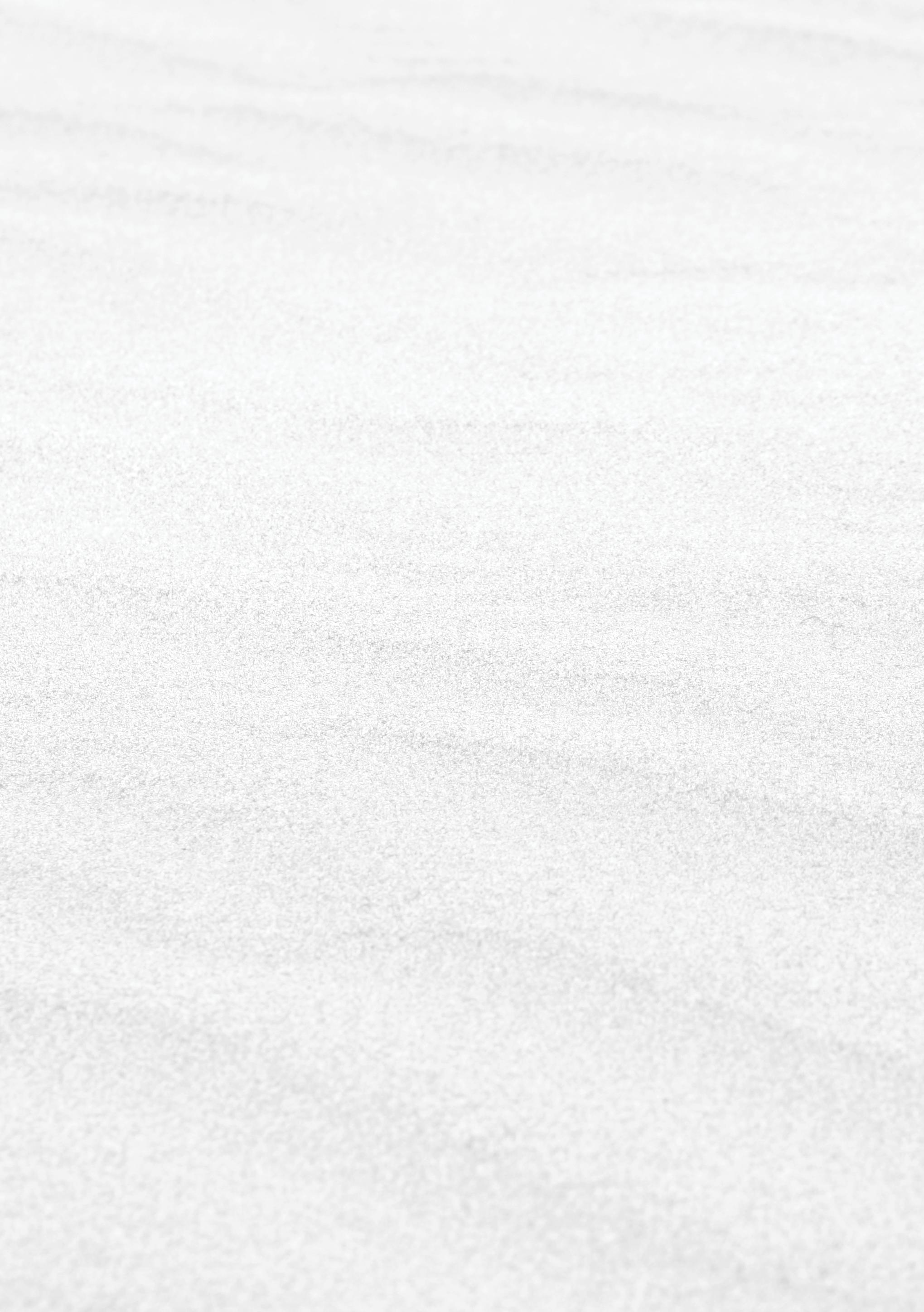




A

In
the end we will conserve only what we love; we will love only what we understand; and we will understand only what we are taught.
-Baba Dioum



Nestled within the pristine embrace of the North Male Atoll, Jumeirah Olhahali Island is a sanctuary of unspoiled natural beauty. Here, among the breathtaking lagoon, lively house reef, and a stunning beach adorned with powdery sands kissed by turquoise waters, we extend a heartfelt invitation to embark on an extraordinary journey into the Maldives' rich marine world.
The Maldives, celebrated for its vibrant marine life, beckons you to immerse yourself in its warm waters and explore the underwater realm. Our resort o ers a diverse collection of excursions and diving experiences that allow you to encounter the Maldives' wonders both above and below the surface.
Dive into the depths aboard a semi-submarine or embrace the world just beneath the waves through snorkelling amid the coral gardens, where a kaleidoscope of marine life dances before your eyes. For certi ed divers, our exhilarating dive excursions unveil the secrets of the Maldivian marine ecosystem. Nurse sharks in secluded caves, graceful turtles, majestic mantas, eagle rays, sharks, and playful dolphins are just a glimpse of what you might encounter. Macro enthusiasts will delight in discovering nudibranchs, shrimp, and other captivating small creatures. With over 20 dive sites within proximity to the resort, each dive promises a new revelation. Notable dive sites to explore include Mahal Caves, Olhahali Ugol, and Olhahali Thila.
If you prefer to stay closer to the surface, join us on a romantic sunset cruise or a thrilling dolphin quest. For those with a penchant for angling, try your hand at pole and line shing, or indulge in a myriad of other o erings. Whether you choose group adventures or seek the intimacy of private trips, we cater to your every desire.








Max. Size: 102 cm
They can be easily be spotted walking around





Sterna sp.
Valla
Max. Size: 63-99 cm
These are the birds you can see diving into surface waters on shallow reefs and lagoons to catch bait sh.
Habitat: Breeding on tree-covered tropical and subtropical islands, foraging over lagoons, atolls, and at sea.
Curiosity: Sometimes referred to as the fairy tern.


They play a crucial role in the Maldives for seed dispersal and pollination.
Habitat: Banyan or Almond trees.
Curiosity: One of the few animals capable of traveling between islands for up to 150km.





Habitat: Island vegetation.
Curiosity: During mating season, males exhibit bright orange heads and shoulders, with black throats to attract mates.


10
Shy and harmless, climbing smooth surfaces and walking upside down on ceilings.
Habitat: Walls and ceilings.
Curiosity: Geckos are known for their vocalisations.





Grapsus albolineatus
Kakuni
Max. Size: 20 cm
Their bodies are coloured in a multitude of greens, blues, oranges, and blacks; feed on algae and detritus from rocks.
Habitat: Beach rock, walls, boat ramps, and jetties.
Curiosity: Exhibits varied colouration throughout their ranges.


Coenobita perlatus
Baraveli
Max. Size: 8 cm
They are not true crabs because they do not have their own shells. Instead, they use shells from dead gastropods for protection of their soft abdomens.
Habitat: Leaf litter or sheltered areas.

Curiosity: Often mistaken for marine animals; they cannot survive submerged in water for extended periods.
Max. Size: 20 cm
The largest tropical ghost crab. Can be distinguished by pointed stalks protruding above the eyes of adults.
Habitat: Sandy beaches, cays.
Curiosity: They live in burrows dug deep into the sand during the day, and are mostly seen at night.






Max. Size: 200 cm

These corals form wide, circular platforms with a rounded growth pattern.
Habitat: Reef environments at depths ranging from 3 to 25 metres.
Curiosity: Table corals can live for over 100 years, making them some of the longest-lived organisms on the reef.

Max. Size: 20 cm
Easily recognised by its evenly spaced branches and distinctive rosette-like appearance.
Habitat: Shallower waters between 3 to 10 metres deep.
Curiosity: The thin coral's delicate, lace-like branches provide intricate hiding spots and shelter for small reef sh and invertebrates.






Pocillopora
Muraka
Max. Size: 17 cm
A vibrant coral that can display pink, cream or blue hues, with unique red-brown nodules on its branches.
Habitat: Upper regions of the reef, at depths less than 10 metres.
Curiosity: This coral's colourful polyps can spontaneously detach and drift away, allowing the colony to reproduce and spread to new areas.

Platygyra
Muraka
Max. Size: 17 cm

A delicately patterned species, characterised by the distinctive cross-sections of its ridged septa.
Habitat: Reef areas between 3 to 30 metres deep.
Curiosity: The sinuous coral's meandering growth pattern is thought to help it maximsze the surface area exposed to sunlight for photosynthesis.

Muraka
Max. Size: 17 cm
Colour can be green, red, brown or yellow with a number of growth forms. The corallites are generally well formed with blade-like septa.
Habitat: Reef environments at depths ranging from 3 to 25 metres.
Curiosity: Their tentacles are covered in specialised stinging cells that it uses to capture small prey passing by.




Goniopora sp.
Muraka
Max. Size: 17 cm

Large coral colonies, sometimes several meters across, with polyps that have 24 tentacles.
Habitat: Found at depths of 5 to 20 metres on the reef.
Curiosity: Their large, tough polyps deter many predators, earning them the "warrior" name.
Heteractis magnifica
Muraka
Max. Size: 100 cm
One of the largest tropical sea anemones, with a column that can reach up to 50 cm in diameter and tentacles ranging from bright green to dark greenish-black.
Habitat: A wide depth range of 1 to 50 metres on the reef.
Curiosity: This anemone's bright colours and large size make it a favourite with scuba divers and snorkellers.


Max. Size: 100 cm
A carpet sea anemone that has an oral disc that can be described as more ovoid than circular that contours to the surrounding substrate and is attached to the substrate by adhesive verrucae, which are wart-like projections.
Habitat: Typically situated in reef areas between 5 to 10 metres deep.
Curiostiy: Merten's anemones can split and divide, allowing a single anemone to populate a wide area of the reef. These types of anemone can become homes for certain anemone sh such as the Nemo.




Fungia sp.
Muraka
Max. Size: 17-30 cm
These corals exhibit a variety of colours, including brown, grey, yellow and white, and are characterised by their highly developed triangular septal teeth.

Habitat: Depths ranging from the surface down to 40 metres on the reef.
Curiosity: They can retract their polyps to conserve energy during times of stress, such as when the water temperature rises.

Kanhambu
Max. Size: 100 cm
Chelonia mydas
Velaa
Max. Size: 150 cm
Distinguished by the four or more scales behind its eyes and its shorter beak, they are known for its olive-colored shell and smooth, heart-shaped carapace.
Habitat: Coral reef environments.
Curiosity: Green turtles are one of the few vertebrates that are entirely herbivorous, feeding exclusively on seagrasses and algae.

The hawksbill turtle has three scales behind the eyes. Also known as "tortoiseshell" because young hawksbills have exceedingly beautiful shells.
Habitat: Coral reef environments.
Curiosity: They are the only sea turtle species with a hooked beak, which they use to access food trapped in coral crevices. They are also the most commonly sighted turtles around Olhahali Island.




Naso brevirostris
Thunbi
Max. Size: 50 cm
Very common in the Maldives. A distinctive sh with a single, horn-like projection on its head, used for grazing on algae and plants.
Habitat: Upper part of reef slopes and drop-o s.
Curiosity: Males can quickly change colour, showing a broad bluish white band to impress other members.
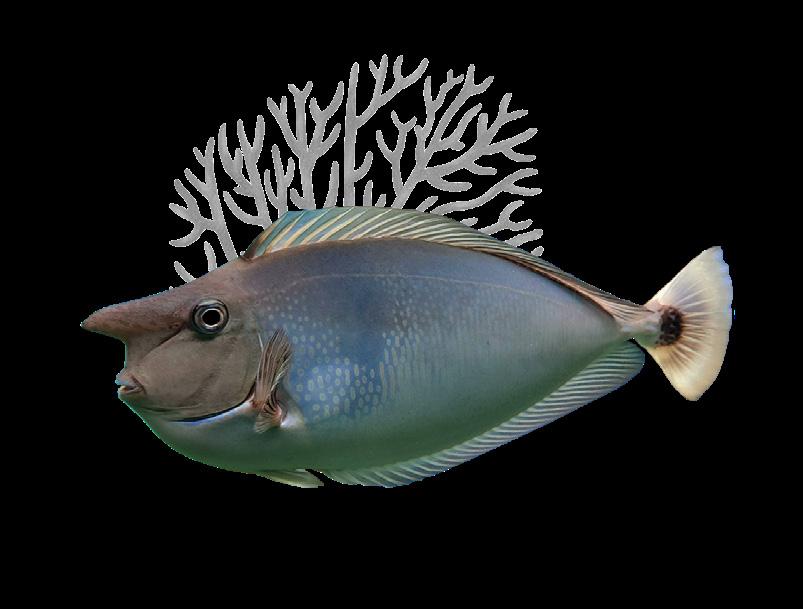
Pygoplites diacanthus
Dhon Kokamas
Max. Size: 25 cm
Identi ed by alternating dark-edged white and orange crossbars.
Habitat: Abundant coral and rocky structures.
Curiosity: Regal angel sh have the ability to change colour dramatically depending on their mood or environment.


Thun Bibee
Max. Size: 15 cm
Small, disc-shaped sh with distinctive vertical black stripes. They feed mainly on coral polyps.
Habitat: Shallows of coral-rich reefs.
Curiosity: Pinstriped butter y sh are known to form monogamous pairs that mate for life, working together to defend their territory.




Zanclus cornutus
Dhidha Mas
Max. Size: 22 cm
Identi ed by elongate snout, dorsal n lament, shape and colour.
Habitat: Tropical reef environments.
Curiosity: The Moorish idol is considered one of the most challenging saltwater sh to care for in home aquariums due to its specialised diet.

Bis Rondu
Max. Size: 35 cm
Balistoides viridescens
Maa Rondu
Max. Size: 75 cm
Also as known as Giant Trigger sh, they are large and powerful with a distinct hump-like pro le. They have incredibly strong jaws that allow them to crush the hard shells of their prey, including clams and sea urchins.
Habitat: Sheltered inner reef slopes.
Curiosity: They are also known to get extremely territorial during mating season and will viciously defend their nesting site against intruders.

Identi ed by black body with large white spots on lower half of the body and yellow to orange mouth.
Habitat: Coral reefs and rocky outcrops.
Curiosity: Clown trigger sh are known to be incredibly territorial and will aggressively defend their home reefs from intruders.








Acanthurus leucosternon
Maagandumas
Max. Size: 20 cm
Identi ed by the black face, white chin, blue body and yellow dorsal n. Look like the cartoon character 'Dory'.
Habitat: Coral reefs and lagoons.
Curiosity: The powder-blue surgeon sh gets its name from the scalpel-like spines on its tail that it can use to defend itself.

Dhonkokamas
Max. Size: 35 cm
Amphiprion nigripes
Maagandumas
Max. Size: 10 cm
A common species easily recognised by the single white bar over the head and black lower ns.
Habitat: Reside in the tentacles of host sea anemones on coral reefs.
Curiosity: The Maldives' very own anemone sh, not sighted anywhere else except nearby Sri Lanka.


They are all blue in colour with distinctive black tips on the tail n.
Habitat: Large, fast-moving schools in open ocean environments.
Curiosity: Known for their ability to change colour rapidly, resembling a shimmering moonlit re ection underwater.






Pomacanthus imperator
Dhonkokamas
Max. Size: 38 cm
They have a unique, brilliant pattern of colouration. The adults are striped with blue and yellow horizontal stripes, a light blue face with a dark blue mask over the eyes and a yellow caudal n.


Habitat: Abundant coral and rocky structures.
Curiosity: Emperor angel sh undergo a dramatic colour transformation as they mature, changing from a juvenile pattern to the iconic adult colouration.
Forcipiger
Thunbibee
Max. Size: 22 cm
Scarus frenatus
Landaa
Max. Size: 47 cm
Males distinguished by abrupt colour to pale green on lower half of head that continues along the body to the tail, females by the brown to pink ns.
Habitat: Reef slopes and drop-o s.
Curiosity: Parrot sh can generate more than 85% of the sand found on white sandy beaches. One parrot sh can poop up to 250g of sand in just one day.


Slender, disc-shaped sh with an elongated, protruding snout.
Habitat: Shallow inner reefs.
Curiosity: The long, protruding snout of the long-nose butter y sh allows it to access food in tight coral crevices.






Ostracion cubicum
Gonu
Max. Size: 45 cm
Easily identi ed by the square yellow body and black spots when they are small. More elongate when they become adults.

Habitat: Protected reefs.
Curiosity: Yellow box sh can in ate their bodies as a defense mechanism, making them harder for predators to swallow.
Fanihandhi
Max. Size: 100 cm
Plectorhinchus vittatus
Kandu Guru
Max. Size: 50 cm
Adults easily recognised by their yellow lips and horizontal black striped pattern.
Habitat: Caves along drop-o s on outer reefs. Curiosity: The striking patterns and colours of the oriental sweetlips help them blend in with the complex, colourful reef environments.

Sleek, fast-moving sh with a distinctive blue and silver coloration.
Habitat: Reef slopes. Blue- n jacks are fast, agile swimmers that often hunt in large, coordinated groups to herd and capture small prey.







Siganus corallinus
Oriya
Max. Size: 35 cm
They have blue spots on yellow background colour and a black area on the throat.

Habitat: Shallow, coral-rich reefs.
Curiosity: Coral rabbit sh are known to be highly cooperative, working together in small groups to forage and defend their territory.
Dhon reendhoomas
Lionfish
Pterois sp.
Fannhaamas
Max. Size: 35 cm
They have long feathery dorsal ns and tentacles above eyes.
Habitat: Tropical reefs and rocky environments.
Curiosity: Lion sh have a unique hunting strategy, using their large, fan-like pectoral ns to herd and corner small sh before striking.

Max. Size: 35 cm

A medium-sized snapper with a distinctive blue and silver striped pattern on its body, and its yellow ventral ns.
Habitat: Near deep channels between the outer reef and the lagoon
Curiosity: Blue-stripped Snappers are known to form large schools, working together to hunt and ambush small prey. They are an attractive sh species and in good light a shoal of these sh adds stunning colouration to the area.








Cephalopholis argus
Mas Faana
Max. Size: 45 cm
Identi ed by colouration, often by a white blotch in front of the pectoral n base.
Habitat: Reefs and rocky areas.
Curiosity: The peacock rock cod has the ability to change colour and pattern to match its surroundings, making it a master of camou age.

Epinephelus merra
Lah Faana Max. Size: 28 cm
Onugandu Thothi
Max. Size: 150 cm
A very elongate sh that has a long lament projecting from the caudal n.
Habitat: Protected areas, near the reef.
Curiosity: The smooth utemouth's long, tubular snout is an adaptation that allows it to feed on small invertebrates and plankton.

Robust-bodied sh with a distinctive honeycomb-like pattern.
Habitat: Coral reefs. Honeycomb groupers are known to form large, coordinated hunting parties to increase their chances of catching prey.







Myripristis adusta
Hiyani dhanbodu
Max. Size: 35 cm
A deep-bodied sh with a large head and distinctive black ns. It has a dark spot behind its head, as opposed to the bar of similar species.
Habitat: Near large reef overhangs.
Curiosity: Shadow n soldier sh are nocturnal, emerging at night to feed on plankton and small crustaceans.
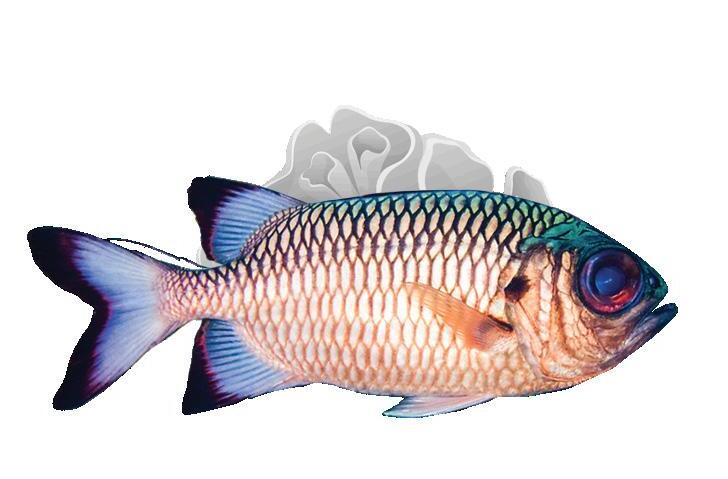
Max. Size: 25 cm
Corythoichthys haematopterus
Fuhthundu
Max. Size: 17 cm
A thin, elongated sh with a long, tube-like snout and a segmented body. Often found in pairs and males have dark blotches along the pouch.
Habitat: Shallow water areas.
Curiosity: Reef-top pipe sh belong to the same family as Seahorses, which are known for their unique courtship rituals, where the male carries the fertilised eggs in a pouch until they hatch.


They are small to medium-sized sh characterized by a slender body with lattened head and teeth- lled jaws.
Habitat: Commonly found buried in the sand or among coral and rocky structures.
Curiosity: Lizard sh are ambush predators, using their camou age and stealth to surprise and capture their prey.






Platybelone argalus
Tholhi
Max. Size: 45 cm

A slender, elongated sh with a long, pointed beak-like jaw.
Habitat: Open ocean and lagoon environments, often in large, coordinated schools.
Curiosity: Needle sh are capable of jumping out of the water and gliding short distances, a behavior known as "breaching."crustaceans.
Carcharhinus amblyrhynchos
Thila miyaru
Max. Size: 225 cm

Carcharhinus melanopterus
Falhu miyaru
Max. Size: 180 cm
Identi ed by the prominent black tips on its ns, this small shark has a streamlined body. Juveniles are specially common in lagoons and often form small schools hunting small shes.
Habitat: Shallow coral reef and lagoon areas.
Curiosity: One of the most noted species by snorkellers. They are skilled predators, using their speed and agility to ambush and capture smaller sh and invertebrates.
A medium-sized, stocky shark with a gray coloration and a rounded snout.

Habitat: Submerged reefs, particulary in channels. Mature females disappear from shark-watching dive site for a few weeks every year between March and May, probably for breeding.




Triaenodon obesus
Othufathi Miyaru
Max. Size: 160 cm
A small, stocky shark with distinctive white-tipped ns and a attened, rounded snout. They are nocturnal hunters, usually seen during the day resting on sand patches.
Habitat: Coral reefs.
Curiosity: Whitetip reef sharks are one of the few shark species that can be safely approached by experienced divers.

Nidhan miyaru
Max. Size: 320 cm
Pateobatis jenkinsii
Naru nagoo madi
Max. Size: 150 cm

A large, bottom-dwelling shark with a attened body, broad head, and two pairs of barbels near its mouth. Mostly nocturnal and hunts primarly for squid and octopus. During the day, often seen in small resting aggregations inside sheltered crevices and caves, or under ledges.
A large, slender ray with a long, whip-like tail and distinctive patterning on its back. Feeds primarly on a variety of sand-dwelling molluscs and crustaceans.
Habitat: Large lagoons.
Curiosity: Non-aggressive, but each of them has up to 3 venomous spines.They are skilled at camou age, able to bury themselves in the sand to ambush unsuspecting prey.




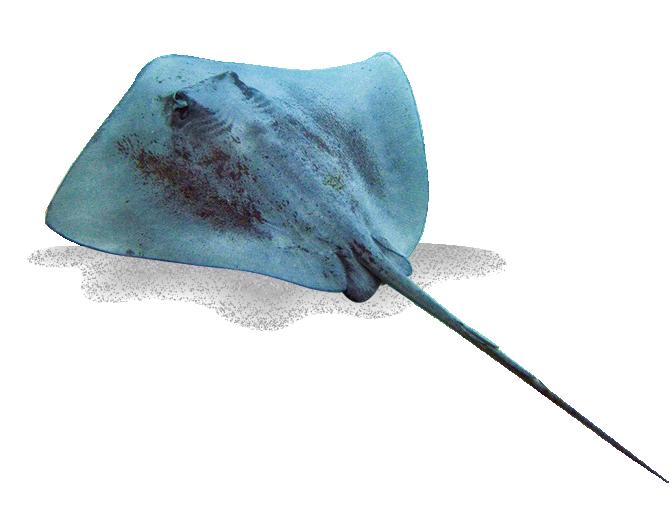
Habitat: Shallow lagoons. Known locally as the sleeping shark.

Pastinachus sephen
Naru nagoo madi
Max. Size: 180 cm
A large, diamond-shaped ray with a long, whip-like tail tipped with a venomous spine.
Habitat: Large shallow lagoons.
Curiosity: Cowtail stingrays are usually very shy and will ee from approaching divers when disturbed. They are known to be social, sometimes forming large aggregations in their preferred habitats.

Aetobatus ocellatus
Vaifiya madi
Max. Size: 300 cm
A large, eagle-like ray with a broad, wing-like disc and distinctive white spots on its back. Often forming large schools well above the bottom or near the surface.
Habitat: Open ocean, as well as coastal reefs and lagoon areas.
Curiosity: White-spotted eaglerays are known to be curious and may approach divers cautiously in the wild, they are fast swimmers.

Naru nagoo madi
Max. Size: 180 cm





A medium-sized ray with a distinctive, spotted "wing-like" disc and a long, thin tail. Largely nocturnal, feeding on a great variety of sand dwelling invertebrates as well as bony shes.
Habitat: Deeper lagoons. One of the largest species of ray, their unique spotted patterns helps them blend in with the dappled light and shadows of the reef.
Manta alfredi
En madi
Max. Size: 500 cm
Characterized by its expansive wingspan, which can reach up to 5.5 meters, and distinctive triangular pectoral ns, the reef manta ray is a graceful swimmer.
Habitat: Commonly seen gliding over coral reefs and seamounts in tropical and subtropical oceans.
Curiosity: The Maldives is home to the world's largest known population of reef manta rays. They are lter feeders, using their large mouths to capture tiny plankton as they swim.

Gymnothorax breedeni
Kalhu ven
Max. Size: 65 cm

A large, predatory eel with a distinctive black coloration around its mouth and gill openings.
Habitat: Reef walls and steep slopes.
Curiosity: Black cheek morays are known for their aggressive nature and can deliver a painful bite if threatened.

A small, compact ray with a triangular disc and a relatively short, whip-like tail. Most commonly encountered by divers and snorkellers.
Habitat: Outer atoll reef crests and slopes.
Curiosity: The short- n pygmy devil ray is one of the smallest species of ray, they can sometimes be mistaken for baby manta rays.




Gymnothorax favagineus
Ven
Max. Size: 200 cm
A medium-sized eel with a unique honeycomb-like pattern of yellow and black markings.
Habitat: Reef walls and steep slopes.
Curiosity: Individuals living on clear coral reefs usually have proporcionally less black than those in turbid waters. They are known to be highly territorial and will ercely defend their hiding spots from other eels and predators.

Max. Size: 100 cm
Heteroconger hassi
Ven Butha
Max. Size: 40 cm
A unique, burrowing eel that lives in colonies, with only its head and upper body protruding from the sand.
Habitat: Sandy or muddy areas adjacent to coral reefs and seagrass beds.
Curiosity: Easily recognised by two large black spots on its sides. Spotted garden eels can quickly retract into their burrows if they sense any potential danger, making them di cult to observe up close.


The largest species of moray eel, with a thick, muscular body and a large, gaping mouth.
Reef walls from intertidal to 50m.
Giant morays are apex predators on the reef, capable of hunting and consuming a wide range of prey, including small sharks and large sh.




Cocos nucifera
Dhivehi Ruh

Max. Size: 30 m

Coconut palms need the humidity and moisture of a tropical or subtropical environment to survive and thrive. Due to the year-round warm weather of the Maldives, the coconut palm is cultivated on a large scale in the country. They are incredibly strong, twith roots extending deep into the soil and can live up to 100 years in the wild.
Habitat: Tropical or subtropical environments.
Curiosity: It is known as a ‘three-generation-tree’ as it provides coconuts to the people who plant it (bearing fruit within 6 to 10 years), their children and grandchildren.


This dense shrub grows very close to the sea exposed to the salt spray, usually on sandy or pebbly soils.
Habitat: Rocky or sandy coasts.
Curiosity: The fruit of beach naupaka oats and can germinate even after being in salt water for as long as a year.



Ficus benghalensis
Nika
Max. Size: 31 m
A type of g tree that can grow to be 100 feet tall and spread out over many acres. It's known for its multiple trunks, which are actually aerial roots that grow down from the branches and take root in the soil.
Habitat: Tropical or subtropical environments.
Curiosity: Banyan trees can live for up to 200 to 500 years.


Heliotropium arboreum
Boshi
Max. Size: 3.6 m
Silky clusters of coiled spikes near the ends of branches where the owers form look like the legs of an Octopus, hence the common name.
Habitat: Beach sands.
Curiosity: It is highly tolerant to salt spray and shields other coastal plants from strong winds.




It has long, thin, sword-like leaves that are arranged in a spiral fashion, giving the tree its name. The leaves can be pale green, rigid, and over three feet long, with spiny margins and midribs, and long, narrow, parallel veins.
Habitat: Sea coasts. Curiosity: Much use is made of the leaves for thatching, mats, hats, ropes, twine, sails for small boats, baskets, and bre products.
Terminalia catappa
Midhili
Max. Size: 35 m

A large tropical tree in the leadwood tree family, which has spiral, stalked leaves that are papery to thinly leathery, dark green above, yellowish green below, and will turn red before falling. As the tree gets older, its crown becomes more attened to form a spreading, vase shape. Its branches are distinctively arranged in tiers.
Habitat: Tropical or subtropical environments.
Curiosity: Then come its fruits, which turn from green to red when ripe, and contain a stone which encloses the famous and delicious almond.

Cyperus alternifolius
Dhaakhiliyyaamaa,
Max. Size: 1.6 m
A versatile plant fantastic for use in ponds, water gardens, container water gardens or even as a houseplant.
Habitat: Their ideal environment is warm and evenly moist with bright, indirect light.
Curiosity: The umbrella tree is an excellent choice for decorative houseplants due to its low maintenance needs and adaptability to various indoor environments.

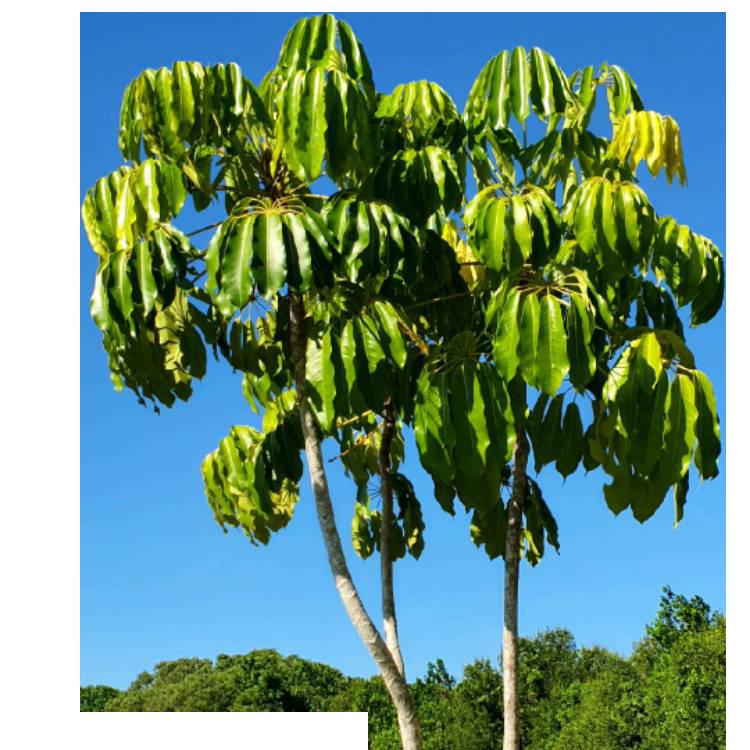
Hudhufuffilaa
Max. Size: 1.8 m
A plant that gets its name from its umbrella-like leaves and crown. It can be a tree or shrub that's native to Australia and New Guinea, or a tropical plant from eastern Asia. Umbrella trees are easy to care for and can last for years. They prefer bright, indirect light and warmer temperatures.
Habitat: Scrub, and thickets in undisturbed and areas.
Curiosity: The leaves can look like a hand with too many ngers, and the way they droop slightly from the stem is said to have a protective e ect.


Plumeria
Gulchampaa
Max. Size: 4 inches
The owers of frangipani trees are usually white and yellow, but cultivated plants can sometimes have reddish owers. The leaves and owers of frangipani trees are arranged in clusters around the tips of the branches.
Habitat: Tropical or subtropical environments.


Curiosity: They are often used in beauty products, soaps, perfumes, and essential oil blends.

Bougainvillea glabra
Bougainvillea,
Max. Size: 0.4 cm
They often have heart-shaped leaves and thorny stems, usually small, tubular, and grown in shades of red, orange, pink, white and some variegated tri-colors, the soft and delicate “paper-like” petals have made it famous across the world.
Habitat: Tropical or subtropical environments.

Ixora coccinea
Thousand Flowers
Max. Size: 1.8 m
The blooms consist of umbels with many red owers that are naturally pollinated by butter ies. The shiny, leathery leaves look elegant and that makes this a nice plant to keep as a tub or houseplant.

Curiosity: It has over 300 di erent varieties, each with its own unique characteristics.

Habitat: Tropical or subtropical environments.
Curiosity: This plant is rich in antioxidants and anti-in ammatory compounds and is used in many medicinal treatments.
Hibiscus rosa-sinensis
Shaimaa
Max. Size: 1.6 m

It is a owering plant that can grow into shrubs, herbs, or small trees. It's a member of the Malvaceae, or mallow family and has over 100 species used for food and medicine around the world.
Habitat: Tropical or subtropical environments.
Curiosity: Many cultures around the world use hibiscus both in food and as a medicine.

Crinum asiaticum
Maakan’dholhu
Max. Size: 1.2 m

A type of water lily species widely planted in many warmer regions as an ornamental. It is a bulb-forming perennial producing an umbel of large, showy owers that are prized by gardeners.
Habitat: Tropical or subtropical environments.
Curiosity: It is toxic if ingested and caution should be exercised around this plant.

Orchidaceae
Oakid
Max. Size: 10 inches
A diverse and widespread group of owering plants with blooms that are often colourful and fragrant.
Habitat: Orchids are cosmopolitan plants that are found in almost every habitat on Earth except glaciers.
Curiosity: It is estimated that there are 17,000 to 35,000 di erent species of orchids.




